Western Flint Glass Company
Reprinted from "Crown Jewels of the Wire", April 2005, pg 28
June 27,1899 - Valverde, Colorado. "Glass Pot Breaks and Burns One
Building", read the headline in the Denver Times. "Fire at an early
hour this morning entirely destroyed one of the buildings of the Valverde Glass
Works in Valverde. The loss will reach at least $5,000 and some estimates place
it higher.
"The fire originated with a glass furnace bursting, scattering the
molten mass about the floor, and starting a conflagration which the men were
unable to control. The works are located outside the city limits, and by the
time the fire department could reach the scene, the building in which the fire
originated was ruined. The building was a one story stone." The building
was owned by Emma Tomson and rented by Robert Good.
The fire ended Good's glass manufacturing business in the Denver area (see
February 2005 edition of Crown Jewels) as he was unable to survive the financial
loss.
In the summer of 1899, new investors rented the damaged glass plant from Emma
Tomson and formed a new business, Western Flint Glass Company. Robert Good
remained in Denver into the fall to assist with reconstruction of the furnace,
and with getting the business back into operation. According to insulator
collector Mike Miller, these new owners were not knowledgeable about the
manufacturing of glass. That fact that resulted in the distinctive colors of WFG
insulators, and also to the demise of the company within a year.
Production seems to have started off well. Mike Miller & Don Reinke
reported in John & Carol McDougald's book, Insulators: A History and Guide
to North American Glass Pin type Insulators, "One of the officers of
Western Flint Glass Company was John H. Porter. A letter from Mr. Frank Galigher,
the plant manager, to John Porter contained a summary of the first three days of
production at the W.F.G. Co. plant. Along with the production totals was a
notation of wages paid to Robert Good, Jr, and the production cost for 2,750 D.P.
(double petticoat) insulators that were produced in the first three and one half
days. By the end of 1899, Robert Good, Jr. moved back to New York."
From the fall of 1899... and until the fall of 1900, W.F.G. Co. produced a
dizzying volume of insulators in a variety of styles. Continues the article in
McDougald's book, "Western Flint Glass Company insulators were made in a
wide variety of colors. It is difficult to identify one as the most common.
Characteristic colors range from dark green to blue, lavender, aqua, and clear.
The plant produced insulators at such a high volume that quality control was
often overlooked. W.F.G. Co. insulators with overpours, underpours and distorted
shapes from improper annealing are not uncommon."
WHAT SEEMS TO HAVE GONE WRONG AT W.F.G.
While a significant part of the business for the Denver area glass houses,
insulator production was always secondary to sales of bottles for foodstuffs and
beverages. And with less able and less experienced leadership than Robert Good,
Jr, the Western Flint Glass Company produced colored glass that failed to meet
the satisfaction of its bottle customers. Mike Miller believes customers
apparently were dissatisfied about packing products in bottles that were blue
and green in color. He says that by the summer of 1900, WFG hired an expert in
glass manufacturing to produce de-colorized (clear) glass. The name was then
changed to Western Glass Manufacturing (WGM) to reflect the company's improved
quality. WGM glass is now noted for its sun colored amethyst colors. However,
Miller notes that "the bottles stayed clear as long as they held beer or
ketchup." It was decades of exposure to solar radiation turned the clear
glass insulators to the various purple colors.
DID WFG MAKE PURPLE GLASS?
Miller also feels rather certain that Western Flint Glass did not make purple
glass. But, you ask, what about the deep purple glass insulators shown in this
article that are embossed WFG? Miller says he believes WGM Company, about midway
through its existence, started re-using some of the WFG molds. Because of the
glass then in use, those insulators turned purple.
THE MOLDS
Western Flint Glass acquired the same insulator molds used by Robert Good,
Jr. The company simply blotted out the old embossing by one means or another,
and embossed the new name into the molds.
Like Good, WFG embossed its name on four styles of insulators: the CD 106,
121, 134 & 162. And, like Good, WFG made several styles of insulators that
were not embossed.
PONY INSULATORS
CD 106 "pony" style insulators made by Western Flint Glass (page
28) are found in a single embossing style reading, W.F.G. Co. / Denver, Colo.
McDougald's Price Guide notes the WFG embossing covers the old embossing through
the use of a slug plate. As with the Robert Good ponies, color varieties are
limited on the CD 106's: light aqua, blue aqua, ice aqua, clear, light steel
blue and ice green.
WESTERN FLINT GLASS COMPANY'S VERY BUSY YEAR
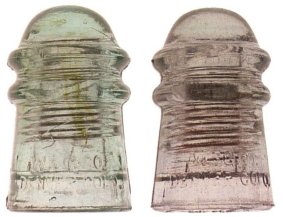
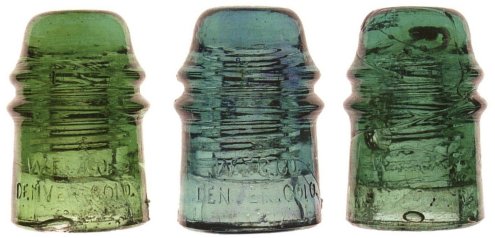
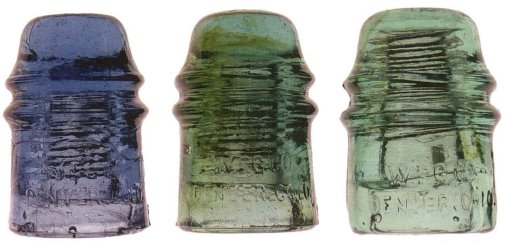
(page 28)
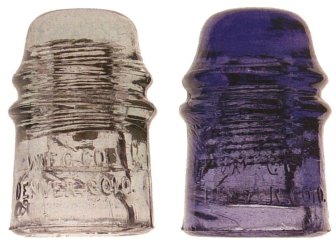
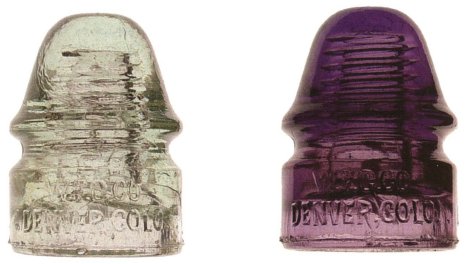
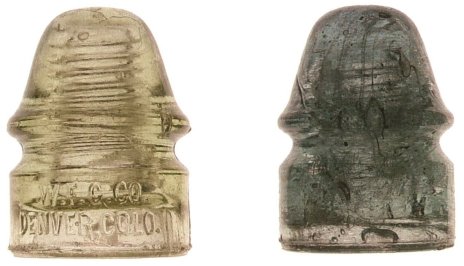
(page 29)
WFG TOLLS
Color varieties in the CD 121 tolls (pages 28 & 29) is a much different
story than the CD 106 ponies. McDougald's price guide lists 27 different colors:
aqua, light aqua, ice aqua, ice blue, steel aqua, blue aqua, gray blue, steel
blue, steel gray, off clear, light lavender, purple tint, clear, delft blue,
milky light aqua, lavender, purple, blue/purple two tone, cornflower blue,
straw, dark lavender, jade aqua milk, green, milky purple, teal green, dark
green & emerald green. We can thank WFG's lack of glass making expertise for
giving us such varied colors.
The tolls are embossed: W.F.G. Co. / Denver, Colo. Varieties include one, two
or three dots located beneath the embossing. The "two dot" varieties
have a period between Denver and Colo instead of a comma. As with the ponies,
the Good name on the tolls is blotted out with a slug plate.
CD 134's
On the CD 134's, the R. Good, Jr. molds (embossed only with the word
"Good") were re-worked by blotting out the letters "GO" with
a circle and the letters "OD" with another circle. The WFG name was
then embossed on the opposite side of the mold. Molds for 134's are identified
with one dot, two dots, and no dot.
Like the tolls, the CD 134 signals are found in a large variety of colors.
The price guide lists nearly two dozen colors: aqua, blue aqua, light aqua,
steel blue, lavender, purple, dark purple, pink, sage green, dark steel blue,
light gray, clear, ice green, light ginger ale, light peach, ginger ale, light
lime green, light yellow green, purple / straw two tone, light yellow, milky
purple, stray, and straw / peach two tone.
CD 162's
In the CD 162 signals, the name "R. Good, Jr" was blotted out with
four circles, and the WFG name was embossed over the top of the blot outs. These
signals are listed in the Price Guide in the following colors: aqua, blue aqua,
off clear, ice blue, light sage green, light steel blue, clear, steel blue, ice
green, purple, dark purple, milky ice aqua, delft blue, ginger ale, purple /
straw two tone, and cornflower blue.
GRAND CANYONS
Collector Mike Miller believes the distinctive style of CD 145
"beehive" insulator made by the Denver glass houses started with
production by R, Good, Jr and continued with the WFG company. These beehives are
nicknamed "Grand Canyons" because many were found on a railroad line
that ran from Williams, Arizona to the South Rim of the Grand Canyon. Miller
notes they were also found on the Santa Fe Prescott & Phoenix railroad line,
and also on Santa Fe railroad lines in Kansas and Colorado. But no matter where
they were found, the beehives are still called "Grand Canyons". Colors listed
in the price guide include: blue aqua, light aqua, ice aqua, off clear, blue
tint, clear, gray, steel blue, light lavender, pink, lime green, steel
blue/lavender two tone, lavender, cornflower blue and dark lavender.
CD 288 & CD 298's
Some unembossed insulators modeled after the Mershon patent (CD 288's &
CD 298's) appear to have been manufactured by Western Flint Glass, according to
collector Mike Miller. Examples are shown on pages 36 & 37. Some examples of
the two CD's were clearly manufactured by Brookfield. Some are embossed Fred M.
Locke. The Brookfield-made varieties are found in the more traditional aqua
colors, and of a higher quality of production. The WFG produced items, as you
can see from the photographs, are often very crudely formed. Miller is planning
to write a future article for Crown Jewels, telling the Mershon story.
TWO PIECE TRANSPOSITIONS
Miller also believes that Western Flint Glass followed R. Good, Jr. in the
production of two piece transpositions. CD 190 / CD 191's are among the rarest
of insulators produced by the glass houses in Denver. There are only around
three dozen tops (CD 191) know to exist; and only two bottoms (CD 190). And we
mean two... as in two bottoms NOT two-dozen bottoms.
In a March 1998 article in Crown Jewels, Miller reported that the western
section of a phone line built out of the town of Silver Cliff used unembossed
purple transposition tops, two per pole, as ordinary line insulators. He says
the CD 191's were on about a two mile stretch of a line that only extended about
six miles total. He found evidence that other insulators on that short line were
purple R. Good, Jr tolls (CD 121's), helping to establish the connection to the
Denver glass houses. It also suggests the purple CD 191's were made by R. Good,
Jr rather than the later WGM Company. Miller noted, "While purple is
synonymous with other manufacturers as with Denver, the purple tops do exhibit
the same graininess as do most R. Good purple insulators."
Purple tops were originally found on that line by a collector in the early
1960's. Miller revisited the line in 1987, finding numerous broken examples and
two unbroken specimens. Because of the how severely damaged most of CD 191's
were, Miller concluded the phone company sent a lineman down the line with a
hammer to discourage the theft of purple insulators by breaking them. (I
encountered this practice as late as 1998 when talking to the owner of a
"farmers' line" in Northern California. The woman had some 400 emerald
green McLaughlin CD 121's in use on her private line, and she told me she
deliberately damaged them with a hammer, even while in use, to keep them from
being stolen.)
In the CJ article Miller wrote, "The bluish aqua tops are a
perfect match in color with a W.F.G. Co. toll. One of these was found at flea
market in Denver brought with common insulators by a couple from northeastern
Colorado. The three steel blue tops match perfectly with WFG tolls and also Grand Canyons. One of
these was found at a Denver area flea market 20 years ago. Another was found by
a retired Mountain Bell employee who had saved a vast quantity of insulators
over his career but had no idea where or when he acquired the top. The two steel
blue violet bottoms were removed from poles by another retired Mountain Bell
lineman. These were stated to have been found near Greeley, Colorado. They also
match WFG tolls and Grand Canyons in color and overall crudeness."
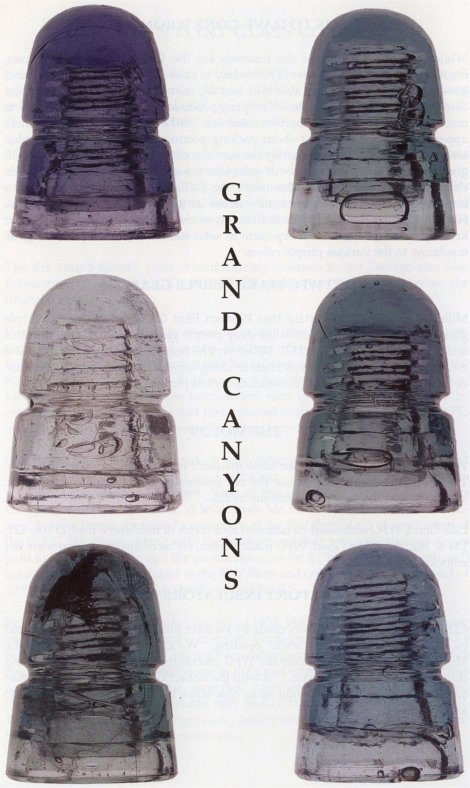
(page 32)
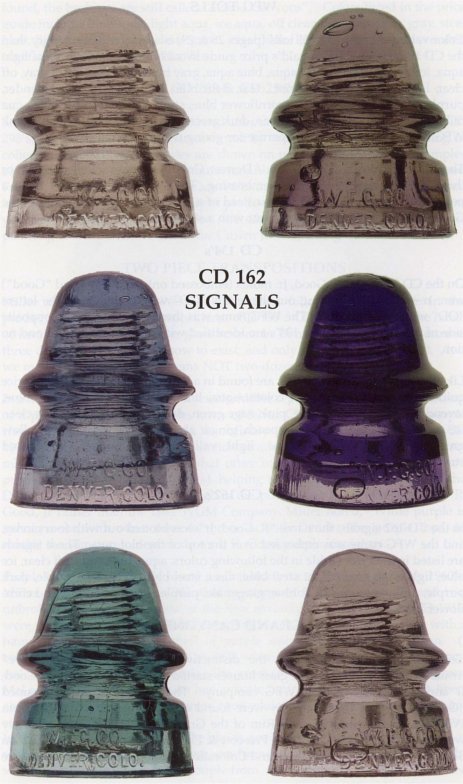
(page 33)
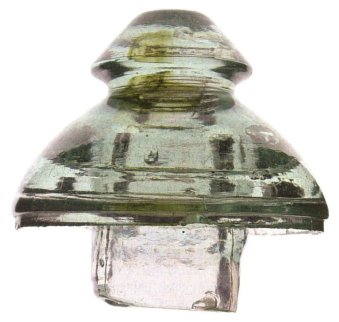
Unembossed CD 288's believed to have been made
by the Western Flint Glass
Company of Denver.
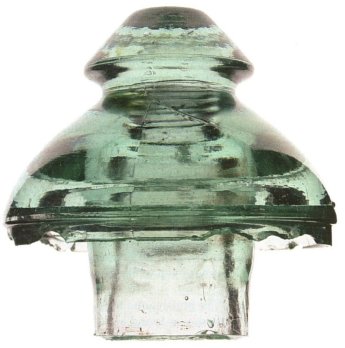
(page 36)
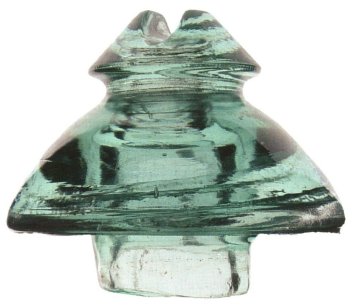
Above: Unembossed CD 298.
Below, another unembossed CD 288.
These crude power
insulators are attributed to the WFG Co.
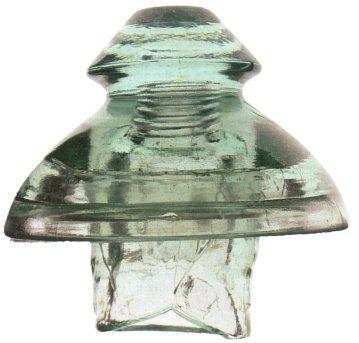
(page 37)
The question remains... what happened, in general, to the bottoms (CD 190's)?
Were they discarded by the phone companies? Or were they not even ordered? Maybe
not even manufactured (beyond a few examples)? A possibility also exists that
some collectors might unknowingly own a Denver top or bottom and not recognize
them to be Denver made insulators.
Miller described some of the differences in the CD 191' s as follows:
1. The dome of the Denver is 1/8 inch wider than that of the Canadian, making
a noticeably flatter dome.
2. The exterior of the skirt rises vertically from the base of the Denver,
while that of the Canadian slopes slightly inward.
3. The interior skirt area of the Denver is more or less filled with glass.
This would be expected with a hand gathered operation such as the Denver plants
had. In the Canadian, the interior of the skirt is open.
4. On (only) the purple tops, the pinhole of the Denver is wider than that of
the Canadian. So much so that the threads of the Denver do not engage securely
with those of a pin.
5. The tope of the pinhole of the Denver is flat and is usually marked with
scratches. In the Canadian to top of the pinhole is concave and is without
scratches.
Photographs of two piece transpositions made in Denver are shown on page 40.
If anyone discovers they have a Denver made two-piece transposition top or
bottom after reading this article, please let us know.
WGM Co
To meet the needs of its bottle customers, Western Flint Glass modified its
glass production in 1900 to produce de-colorized (clear) glass. The name was
changed to Western Glass Manufacturing Company to emphasize the improved
quality. Collectors Tom Katonak and Mike Miller are teaming up to write an
article on WGM's that Crown Jewels will publish later this spring or summer.
WHERE THEY WERE FOUND
In the February 2005 article on R. Good, Jr insulators, we mentioned that
Denver made insulators were found over a wide area of the American West..
Afterwards, we heard from a collector who traveled all around the West in the
1960's trading out collectible insulators in use on lines, and replacing them
with Denver insulators which were common to him. He recalled taking down purple
Canadian insulators and replacing them with purple Denver insulators. If some of
you Canadian collectors found purple Denvers in use on lines in your area, now
you know why.
Nevertheless, even though they were only manufactured for one year,
insulators made by the Western Flint Glass Company were placed in service in a
number of states including Colorado, Kansas, New Mexico and Arizona.
COLLECTING DENVERS
If you are searching for something fun, and not excessively expensive, to
collect or specialize in, the Denver insulators are worthy of consideration.
They are colorful, come in a variety of CD styles, were used in the
industrialization of the American West, and represent a ripe opportunity for
historical study.
Howard Banks
REFERENCES
Crown Jewels of the Wire, March 1998, article by Mike Miller.
Crown Jewels of the Wire, February 2005, article by Howard Banks.
Insulators: A History and Guide to North American Glass Pintype Insulators,
John & Carol McDougald, 1990.
Insulators Price Guide, John & Carol McDougald, 2003.
Photography by Howard Banks
Photo editing by David Banks
Thanks to Mike Miller for allowing us to photograph his insulators for this
article.
Thanks to Tommy Bolack for his grant to pay for the color printing in Crown
Jewels.
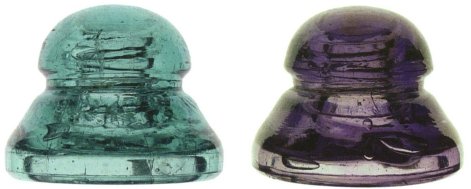
DENVER TRAMPS
CD 190 / 191's made by the Denver glass houses are hard to find. Purple
pieces are believed to have been made by R. Good, Jr. while the aqua and
lavender items are attributed to WFG Co.
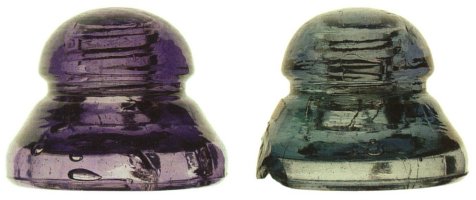
How scarce are these pieces? Only three aqua tops are known, and no bottoms
(none). There exists three lavender tops, and only two bottoms. As for the
purples... about thirty tops are known, but no bottoms.
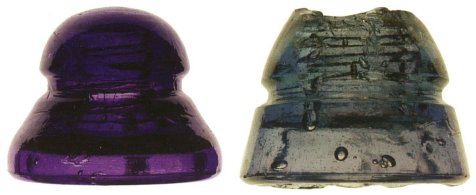
(page 40)
Western Flint Glass Company
Denver's Era of Blues and Greens
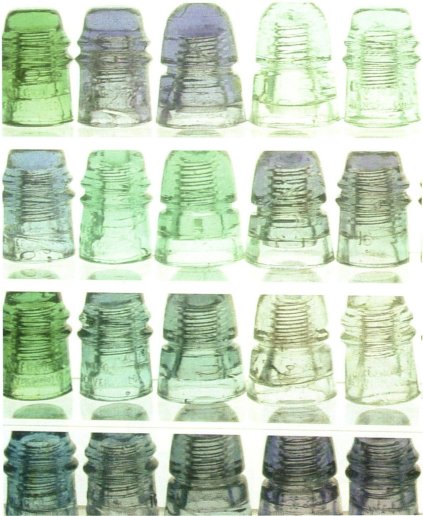
Shown is a portion of a display of Denver insulators featuring WFG's and
"Grand Canyon" beehives believed to have been produced by the Western
Flint Glass Company. The display reveals the dominance of blues and greens in
Denver glass during the WFG era.
(page 41)
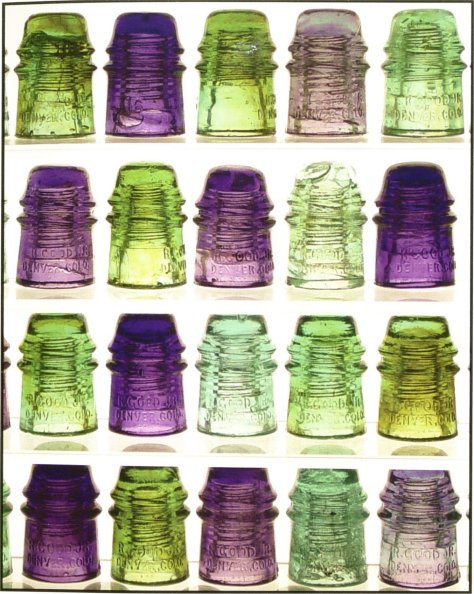
Crown Jewels this month runs the second of three articles
about insulators manufactured in Denver, Colorado. While this month's article is
about WFG's, we couldn't pass up running this colorful picture. These are all R.
Good, Jr tolls from the Mike Miller Collection.
(inside back cover)
| 